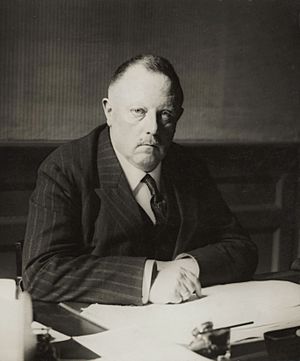Willem Hendrik Keesom facts for kids
Quick facts for kids
Willem Keesom
|
|
|---|---|

Willem Keesom in 1926
|
|
| Born | 21 June 1876 Texel, Netherlands
|
| Died | 3 March 1956 (aged 79) Leiden, Netherlands
|
| Known for | helium |
| Scientific career | |
| Fields | physics |
| Doctoral advisor | Johannes Diderik van der Waals |
Willem Hendrik Keesom (/ˈkeɪsoʊm/) (21 June 1876, Texel – 3 March 1956, Leiden) was a Dutch physicist who, in 1926, invented a method to freeze liquid helium. He also developed the first mathematical description of dipole–dipole interactions in 1921. Thus, dipole–dipole interactions are also known as Keesom interactions. He was previously a student of Heike Kamerlingh Onnes, who had discovered superconductivity (a feat for which Kamerlingh Onnes received the 1913 Nobel Prize in Physics).
He also discovered the lambda point transition specific-heat maximum between Helium-I and Helium-II in 1930.
In 1924 he became member of the Royal Netherlands Academy of Arts and Sciences. In 1966, the minor planet 9686 Keesom was named after him.
See also
 In Spanish: Willem Hendrik Keesom para niños
In Spanish: Willem Hendrik Keesom para niños

